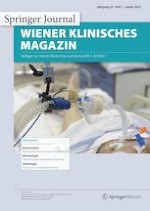10.01.2022 | Intensivmedizin
Hypo- und Hypernatriämien auf der Intensivstation
Fallstricke des Volumenmanagements
Erschienen in: Wiener klinisches Magazin | Ausgabe 1/2022
Einloggen, um Zugang zu erhaltenZusammenfassung
Hypo- und Hypernatriämien sind bei intensivmedizinischen Patienten sehr häufig und stehen in engem Zusammenhang mit Volumenstörungen und dem Volumenmanagement auf der Intensivstation. Sie sind mit einer längeren intensivstationären Verweildauer und einer deutlich erhöhten Mortalität assoziiert und ihre Behandlung ist komplexer, als es auf den ersten Blick scheint. Hyponatriämien werden anhand von Tonizität und Volumenstatus differenziert. Bei hypertonen und isotonen Hyponatriämien steht die Therapie der zugrunde liegenden Hyperglykämie im Vordergrund. Bei hypotonen hypovolämischen Hyponatriämien erfolgt eine Therapie mit balancierten kristalloiden Lösungen, bei schweren eu-/hypervolämischen hypotonen Hyponatriämien eine Akuttherapie mit hypertoner Kochsalzlösung. Hypervolämische Hypernatriämien treten fast ausschließlich bei intensivstationären Patienten auf und sind oft durch die Infusion hypertoner Lösungen bedingt. Es gibt wenig Evidenz für die Therapie, wobei hypotone Infusionen in Verbindung mit einer diuretischen Therapie ein Ansatz sein können. Es sollte großes Augenmerk auf die Prävention gelegt werden und die Infusion hypertoner Lösungen vermieden werden. Störungen der Plasmanatriumkonzentration sind häufig, bedürfen großer Aufmerksamkeit und es sollte eine sorgfältige diagnostische Einteilung erfolgen sowie die Volumentherapie entsprechend ausgerichtet werden.
Anzeige
